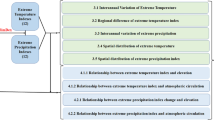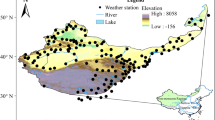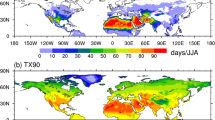Abstract
Climate changes are likely to increase the risk of numerous extreme weather events throughout the world. The objectives of this study were to investigate and analyze the temporal-spatial variability patterns of temperature extremes based on daily maximum (TX) and minimum temperature (TN) data collected from 49 meteorological stations in Xinjiang of China during 1960–2015. These temperature data were also used to assess the impacts of altitude on the temperature extremes. Additionally, possible teleconnections with the large-scale circulation pattern (the El Nino-Southern Oscillation, ENSO and Arctic Oscillation, AO) were investigated. Results showed that all percentile indices had trends consistent with warming in most parts of Xinjiang during 1960–2015, but the warming was more pronounced for indices derived from TN compared to those from TX. The minimum TN and maximum TX increased at rates of 0.16°C/10 yr and 0.59°C/10 yr, respectively during 1960–2015. Accordingly, the diurnal temperature range showed a significant decreasing trend of −0.23°C/10 yr for the whole study area. The frequency of the annual average of the warm events showed significant increasing trends while that of the cold events presented decreasing trends. Over the same period, the number of frost days showed a statistically significant decreasing trend of −3.37 d/10 yr. The number of the summer days and the growing season showed significant increasing trends at rates of 1.96 and 2.74 d/10 yr, respectively. The abrupt change year of each index was from the 1980s to the 1990s, showing that this periodic interval was a transitional phase between cold and warm climate change. Significant correlations of temperature extremes and elevation included the trends of tropical nights, growing season frequency, and cold spell duration indicator. This result also indicated the clear and complex local influence on climatic extremes. In addition, the relationship between each index of the temperature extremes with large-scale atmospheric circulation (ENSO and AO) demonstrated that the influence of ENSO on each index of the temperature extremes was greater than that of the AO in Xinjiang.
Similar content being viewed by others
References
Abatan A A, Abiodun B J, Lawal K A et al., 2016. Trends in extreme temperature over Nigeria from percentile-based threshold indices. International Journal of Climatolog., 36(6): 2527–2540. doi: https://doi.org/10.1002/joc.4510
Alexander L V, Zhang X, Peterson T C et al., 2006. Global observed changes in daily climate extremes of temperature and precipitation. Journal of Geophysical Research: Atmospher., 111(D5): D05109. doi: https://doi.org/10.1029/2005JD006290
Bonsal B R, Zhang X, Vincent L A et al., 2001. Characteristics of daily and extreme temperatures over Canada. Journal of Climat., 14(9): 1959–1976. doi: https://doi.org/10.1175/1520-0442(2001)014<1959:codaet>2.0.co;2
Braganza K, Karoly D J, Hirst A C et al., 2004. Simple indices of global climate variability and change Part II: attribution of climate change during the twentieth century. Climate Dynamic., 22(8): 823–838. doi: https://doi.org/10.1007/s00382-004-0413-1
Caesar J, Alexander L V, Trewin B et al., 2011. Changes in temperature and precipitation extremes over the Indo-Pacific region from 1971 to 2005. International Journal of Climatolog., 31(6): 791–801. doi: https://doi.org/10.1002/joc.2118
Chen J L, Wilson C R, Tapley B D 2013. Contribution of ice sheet and mountain glacier melt to recent sea level rise. Nature Geoscienc., 6(7): 549–552. doi: https://doi.org/10.1038/ngeo1829
Chen S, Chen X G, Xu J T 2016. Assessing the impacts of temperature variations on rice yield in China. Climatic Chang., 138(1–2): 191–205. doi: https://doi.org/10.1007/s10584-016-1707-0
Chen Y, Zhai P M 2013. Persistent extreme precipitation events in China during 1951–2010. Climate Researc., 57: 143–155. doi: https://doi.org/10.3354/cr01171
Chen Y N, Deng H J, Li B F et al., 2014. Abrupt change of temperature and precipitation extremes in the arid region of Northwest China. Quaternary Internationa., 336: 35–43. doi: https://doi.org/10.1016/j.quaint.2013.12.057
Choi G, Collins D, Ren G Y et al., 2009. Changes in means and extreme events of temperature and precipitation in the Asia-Pacific Network region, 1955–2007. International Journal of Climatolog., 29(13): 1906–1925. doi: https://doi.org/10.1002/joc.1979
Donat M G, Alexander L V, Yang H et al., 2013. Updated analyses of temperature and precipitation extreme indices since the beginning of the twentieth century: the hadex2 dataset. Journal of Geophysical Research: Atmospher., 118(5): 2098–2118. doi: https://doi.org/10.1002/jgrd.50150
Degaetano A T, Allen R J 2002. Trends in twentieth-century temperature extremes across the United States. Journal of Climat., 15(22): 3188–3205. doi: https://doi.org/10.1175/1520-0442(2002)015<3188:TITCTE>2.0.CO;2
Fu G B, Chen S L, Liu C M et al., 2004. Hydro-climatic trends of the Yellow River Basin for the last 50 years. Climatic Chang., 65: 149–178. doi: https://doi.org/10.1023/b:clim.0000037491.95395.bb
Fontaine B, Janicot S, Monerie P A, 2013. Recent changes in air temperature, heat waves occurrences, and atmospheric circulation in northern Africa. Journal of Geophysical Research: Atmospher., 118(15): 8536–8552. doi: https://doi.org/10.1002/jgrd.50667
Gao Y, Feng Q, Liu W et al., 2015. Changes of daily climate extremes in Loess Plateau during 1960–2013. Quaternary Internationa., 371: 5–21. doi: https://doi.org/10.1016/j.quaint.2014.08.052
Garcia-Herrera R, Diaz J, Trigo R M et al., 2010. A review of the European summer heat wave of 2003. Critical Reviews in Environmental Science and Technolog., 40(4): 267–306. doi: https://doi.org/10.1080/10643380802238137
Goossens C H, Berger A 1986. Annual and seasonal climatic variations over the northern hemisphere and Europe during the last century. Annales Geophysica., 4(4): 385–400.
Goswami B N, Venugopal V, Sengupta D et al., 2006. Increasing trend of extreme rain events over India in a warming environment. Scienc., 314(5804): 1442–1445. doi: https://doi.org/10.1126/science.1132027
Grinsted A, Moore J C, Jevrejeva S 2004. Application of the cross wavelet transform and wavelet coherence to geophysical time series. Nonlinear Processes in Geophysic., 11(5–6): 561–566. doi: https://doi.org/10.5194/npg-11-561-2004
Grotjahn R, Black R, Leung R et al., 2016. North American extreme temperature events and related large scale meteorological patterns: a review of statistical methods, dynamics, modeling, and trends. Climate Dynamic., 46(3–4): 1151–1184. doi: https://doi.org/10.1007/s00382-015-2638-6
Guan Y H, Zhang X C, Zheng F L et al., 2015. Trends and variability of daily temperature extremes during 1960–2012 in the Yangtze River basin, China. Global and Planetary Chang., 124: 79–94. doi: https://doi.org/10.1016/j.gloplacha.2014.11.008
Guan Y H, Zheng F L, Zhang X C et al., 2017. Trends and variability of daily precipitation and extremes during 1960–2012 in the Yangtze River basin, China. International Journal of Climatolog., 37(3): 1282–1298. doi: https://doi.org/10.1002/joc.4776
Hegerl G C, Zwiers F W, Stott P A et al., 2004. Detectability of anthropogenic changes in annual temperature and precipitation extremes. Journal of Climat., 17(19): 3683–3700. doi: https://doi.org/10.1175/1520-0442(2004)017<3683:doacia>2.0.co;2
Hundecha Y, Bárdossy A, 2005. Trends in daily precipitation and temperature extremes across western Germany in the second half of the 20th Century. International Journal of Climatolog., 25(9): 1189–1202. doi: https://doi.org/10.1002/joc.1182
Huo Z L, Dai X Q, Feng S Y et al., 2013. Effect of climate change on reference evapotranspiration and aridity index in arid region of China. Journal of Hydrolog., 492: 24–34. doi: https://doi.org/10.1016/j.jhydrol.2013.04.011
IPCC, 2013. Climate Change 2013: The Physical Science Basis. Contribution of Working Group I to the Fifth Assessment Report of the Intergovernmental Panel on Climate Change. Cambridge, UK and New York, NY: Cambridge University Press.
Jiang F Q, Hu R J, Wang S P et al., 2013. Trends of precipitation extremes during 1960–2008 in Xinjiang, the northwest China. Theoretical and Applied Climatolog., 111(1–2): 133–148. doi: https://doi.org/10.1007/s00704-012-0657-3
Katz R W, Brown B G 1992. Extreme events in a changing climate: variability is more important than averages. Climatic Chang., 21(3): 289–302. doi: https://doi.org/10.1007/bf00139728
Kenyon J, Hegerl G C 2008. Influence of modes of climate variability on global temperature extremes. Journal of Climat., 21(15): 3872–3889. doi: https://doi.org/10.1175/2008jcli2125.1
Kiktev D, Sexton D M, Alexander L et al., 2003. Comparison of modeled and observed trends in indices of daily climate extremes. Journal of Climat., 16(22): 3560–3571. doi: https://doi.org/10.1175/1520-0442(2003)016<3560:COMAOT>2.0.CO;2
Kruger A C, Sekele S S 2013. Trends in extreme temperature indices in South Africa: 1962–2009. International Journal of Climatolog., 33(3): 661–676. doi: https://doi.org/10.1002/joc.3455
Kundzewicz Z W 2016. Extreme weather events and their consequences. Papers on Global Change IGB., 23(1): 59–69. doi: https://doi.org/10.1515/igbp-2016-0005
Li Z X, He Y Q, Wang P Y et al., 2012a. Changes of daily climate extremes in southwestern China during 1961–2008. Global and Planetary Chang., 80–81: 255–272. doi: https://doi.org/10.1016/j.gloplacha.2011.06.008
Li Z X, He Y Q, Theakstone W H et al., 2012b. Altitude dependency of trends of daily climate extremes in southwestern China, 1961–2008. Journal of Geographical Science., 22(3): 416–430. doi: https://doi.org/10.1007/s11442-012-0936-z
Ling H B, Xu H L, Fu J Y et al., 2012. Analysis of temporal-spatial variation characteristics of extreme air temperature in Xinjiang, China. Quaternary Internationa., 282: 14–26. doi: https://doi.org/10.1016/j.quaint.2012.01.033
Liu B H, Xu M, Henderson M et al., 2004. Taking China’s temperature: daily range, warming trends, and regional variations, 1955–2000. Journal of Climat., 17(22): 4453–4462. doi: https://doi.org/10.1175/3230.1
Liu Q, Yang Z, Cui B 2008. Spatial and temporal variability of annual precipitation during 1961–2006 in Yellow river basin, China. Journal of Hydrolog., 361(3–4): 330–338. doi: https://doi.org/10.1016/j.jhydrol.2008.08.002
New M, Hewitson B, Stephenson D B et al., 2006. Evidence of trends in daily climate extremes over southern and west Africa. Journal of Geophysical Research: Atmospher., 111(D14): D14102. doi: https://doi.org/10.1029/2005JD006289
Overland J E, Wang M Y, Walsh J E et al., 2014. Future arctic climate changes: adaptation and mitigation time scales. Earths Futur., 2(2): 68–74. doi: https://doi.org/10.1002/2013EF000162
Piao S L, Ciais P, Huang Y et al., 2010. The impacts of climate change on water resources and agriculture in China. Natur., 467(7311): 43–51. doi: https://doi.org/10.1038/nature09364
Renom M, Rusticucci M, Barreiro M, 2011. Multidecadal changes in the relationship between extreme temperature events in Uruguay and the general atmospheric circulation. Climate Dynamic., 37(11–12): 2471–2480. doi: https://doi.org/10.1007/s00382-010-0986-9
Revadekar J V, Kothawale D R, Patwardhan S K et al., 2012. About the observed and future changes in temperature extremes over India. Natural Hazard., 60(3): 1133–1155. doi: https://doi.org/10.1007/s11069-011-9895-4
Shi Y F, Shen Y P, Kang E S et al., 2007. Recent and future climate change in northwest China. Climatic Chang., 80(3–4): 379–393. doi: https://doi.org/10.1007/s10584-006-9121-7
Skansi M D L M, Brunet M, Sigró J et al., 2013. Warming and wetting signals emerging from analysis of changes in climate extreme indices over South America. Global and Planetary Chang., 100: 295–307. doi: https://doi.org/10.1016/j.gloplacha.2012.11.004
Sun W Y, Mu X M, Song X Y et al., 2016. Changes in extreme temperature and precipitation events in the Loess Plateau (China) during 1960–2013 under global warming. Atmospheric Researc., 168: 33–48. doi: https://doi.org/10.1016/j.atmosres.2015.09.001
Tabari H, Talaee P H 2011. Analysis of trends in temperature data in arid and semi-arid regions of Iran. Global and Planetary Chang., 79(1–2): 1–10. doi: https://doi.org/10.1016/j.gloplacha.2011.07.008
Torrence C, Compo G P, 1998. A practical guide to wavelet analysis. Bulletin of the American Meteorological Societ., 79(1): 61–78. doi: https://doi.org/10.1175/1520-0477(1998)079<0061:APGTWA>2.0.CO;2
Vincent L A, Aguilar E, Saindou M et al., 2011. Observed trends in indices of daily and extreme temperature and precipitation for the countries of the western Indian Ocean, 1961–2008. Journal of Geophysical Research: Atmospher., 116(D10): D10108. doi: https://doi.org/10.1029/2010JD015303
Vose R S, Easterling D R, Gleason B, 2005. Maximum and minimum temperature trends for the globe: an update through 2004. Geophysical Research Letter., 32(23): L23822. doi: https://doi.org/10.1029/2005GL024379
Wang B L, Zhang M J, Wei J L et al., 2013a. Changes in extreme events of temperature and precipitation over Xinjiang, northwest China, during 1960–2009. Quaternary Internationa., 298: 141–151. doi: https://doi.org/10.1016/j.quaint.2012.09.010
Wang G, Yan D H, He X Y et al., 2018. Trends in extreme temperature indices in Huang-Huai-Hai river basin of China during 1961–2014. Theoretical and applied Climatolog., 134(1–2): 51–65. doi: https://doi.org/10.1007/s00704-017-2252-0
Wang H J, Chen Y N, Chen Z S et al., 2013b. Changes in annual and seasonal temperature extremes in the arid region of China, 1960–2010. Natural Hazard., 65(3): 1913–1930. doi: https://doi.org/10.1007/s11069-012-0454-4
Wang S J, Zhang M J, Wang B L et al., 2013c. Recent changes in daily extremes of temperature and precipitation over the western Tibetan Plateau, 1973–2011. Quaternary Internationa., 313–314: 110–117. doi: https://doi.org/10.1016/j.quaint.2013.03.037
Xu X, Du Y G, Tang J P et al., 2011. Variations of temperature and precipitation extremes in recent two decades over China. Atmospheric Researc., 101(1–2): 143–154. doi: https://doi.org/10.1016/j.atmosres.2011.02.003
Yang X C, Zhang Y L, Zhang W et al., 2006. Climate change in Mt. Qomolangma region in China during the last 34 years. Acta Geographica Sinic., 61(7): 687–696. doi: https://doi.org/10.1016/S1003-6326(06)60040-X
You Q L, Kang S C, Aguilar E et al., 2011. Changes in daily climate extremes in China and their connection to the large scale atmospheric circulation during 1961–2003. Climate Dynamic., 36(11–12): 2399–2417. doi: https://doi.org/10.1007/s00382-009-0735-0
Yu L J, Sui C J, Lenschow D H et al., 2017. The relationship between wintertime extreme temperature events north of 60°N and large-scale atmospheric circulations. International Journal of Climatolog., 37(S1): 597–611. doi: https://doi.org/10.1002/joc.5024
Zhai Panmao, Pan Xiaohua, 2003. Change in extreme temperature and precipitation over Northern China during the second half of the 20th century. Acta Geographica Sinic., 58(S1): 1–10. (in Chinese)
Zhang K X, Pan S M, Zhang W et al., 2015. Influence of climate change on reference evapotranspiration and aridity index and their temporal-spatial variations in the Yellow River Basin, China, from 1961 to 2012. Quaternary Internationa., 380–381: 75–82. doi: https://doi.org/10.1016/j.quaint.2014.12.037
Zhang K X, Qian X Q, Liu P X et al., 2017. Variation characteristics and influences of climate factors on aridity index and its association with AO and ENSO in northern China from 1961 to 2012. Theoretical and applied Climatolog., 130(1–2): 523–533. doi: https://doi.org/10.1007/s00704-016-1887-6
Zhang Q, Singh V P, Li J F et al., 2012. Spatio-temporal variations of precipitations extremes in Xinjiang, China. Journal of Hydrolog., 434–435: 7–18. doi: https://doi.org/10.1016/j.jhydrol.2012.02.038
Zhang X B, Aguilar E, Sensoy S et al., 2005. Trends in middle east climate extreme indices from 1950 to 2003. Journal of Geophysical Research: Atmospher., 110(D22): D22104. doi: https://doi.org/10.1029/2005JD006181
Zhang X Q, Ren Y, Yin Z Y et al., 2009. Spatial and temporal variation patterns of reference evapotranspiration across the Qinghai-Tibetan Plateau during 1971–2004, Journal of Geophysical Research: Atmospher., 114: 1–14. doi: https://doi.org/10.1029/2009jd011753
Zhong K Y, Zheng F L, Wu H Y et al., 2017. Dynamic changes in temperature extremes and their association with atmospheric circulation patterns in the Songhua river basin, China. Atmospheric Researc., 190(1): 77–88. doi: https://doi.org/10.1016/j.atmosres.2017.02.012
Zhou Yaqing, Ren Guoyu, 2010. Variation characteristics of extreme temperature indices in mainland China during 1956–2008. Climatic and Environmental Researc., 15(4): 405–417. (in Chinese)
Author information
Authors and Affiliations
Corresponding authors
Additional information
Foundation item: Under the auspices of Natural Science Foundation of Jiangsu Province (No. BK20171292), China Postdoctoral Science Foundation (No. 2017M611922, 2018T110559), Postdoctoral Science Foundation of Jiangsu Province (No. 1701186B)
Rights and permissions
About this article
Cite this article
Zhang, K., Dai, S. & Dong, X. Dynamic Variability in Daily Temperature Extremes and Their Relationships with Large-scale Atmospheric Circulation During 1960–2015 in Xinjiang, China. Chin. Geogr. Sci. 30, 233–248 (2020). https://doi.org/10.1007/s11769-020-1106-3
Received:
Accepted:
Published:
Issue Date:
DOI: https://doi.org/10.1007/s11769-020-1106-3




